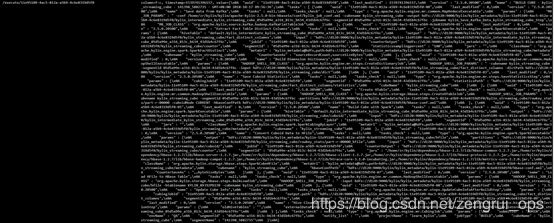Kylin源码分析系列一—任务调度
Kylin源码分析系列一—任务调度
注:Kylin源码分析系列基于Kylin的2.5.0版本的源码,其他版本可以类比。
一. 相关介绍
Kylin在Web上触发Cube的相关操作后并不是马上执行相关的操作,而是将构建的任务提交到任务调度服务,任务调度服务每隔一段时间会将提交了未执行的job进行调度执行,默认是30s调度一次,可根据配置项kylin.job.scheduler.poll-interval-second来配置调度时间间隔。
任务调度服务的服务类为JobService,包路径:org.apache.kylin.rest.service.JobService。JobService是通过实现InitializingBean接口,继而实现afterPropertiesSet的方法 ,然后通过配置spring加载bean的方式被初始化的;具体是通过配置文件来装配bean的,涉及到的配置文件有:在./tomcat/webapps/kylin/WEB-INF/web.xml中引入了./tomcat/webapps/kylin/WEB-INF/classes/applicationContext.xml,然后在applicationContext.xml中配置有:
然后spring去扫描目录org.apache.kylin.rest下的标有@Component的类,并注册成bean。由于JobService是通过实现InitializingBean接口,继而实现afterPropertiesSet的方法来初始化bean的,所以在JobService这个bean被初始化的时候,afterPropertiesSet会被调用执行,继而实现JobService的初始化,kylin中的其他服务也是这要被初始化的。
二. 源码分析
下面看下源码:
任务调度服务初始化:
public void afterPropertiesSet() throws Exception {
String timeZone = getConfig().getTimeZone();
TimeZone tzone = TimeZone.getTimeZone(timeZone);
TimeZone.setDefault(tzone);
final KylinConfig kylinConfig = KylinConfig.getInstanceFromEnv();
//获取配置的任务调度器,默认为org.apache.kylin.job.impl.threadpool.DefaultScheduler
final Scheduler scheduler = (Scheduler) SchedulerFactory
.scheduler(kylinConfig.getSchedulerType());
new Thread(new Runnable() {
@Override
public void run() {
try {
//调度服务初始化
scheduler.init(new JobEngineConfig(kylinConfig), new ZookeeperJobLock());
if (!scheduler.hasStarted()) {
logger.info("scheduler has not been started");
}
} catch (Exception e) {
throw new RuntimeException(e);
}
}
}).start();
Runtime.getRuntime().addShutdownHook(new Thread(new Runnable() {
@Override
public void run() {
try {
scheduler.shutdown();
} catch (SchedulerException e) {
logger.error("error occurred to shutdown scheduler", e);
}
}
}));
}
Kylin的任务调度器有三种:
public Map getSchedulers() {
Map r = Maps.newLinkedHashMap();
r.put(0, "org.apache.kylin.job.impl.threadpool.DefaultScheduler");
r.put(2, "org.apache.kylin.job.impl.threadpool.DistributedScheduler");
r.put(77, "org.apache.kylin.job.impl.threadpool.NoopScheduler");
r.putAll(convertKeyToInteger(getPropertiesByPrefix("kylin.job.scheduler.provider.")));
return r;
} 通过配置项kylin.job.scheduler.default来配置,默认配置为0,即为DefaultScheduler,下面回到任务调度服务的初始化,调用DefaultScheduler的init方法:
public synchronized void init(JobEngineConfig jobEngineConfig, JobLock lock) throws SchedulerException {
jobLock = lock;
String serverMode = jobEngineConfig.getConfig().getServerMode();
//只有服务模式为job和all的需要运行任务调度服务,query不需要
if (!("job".equals(serverMode.toLowerCase()) || "all".equals(serverMode.toLowerCase()))) {
logger.info("server mode: " + serverMode + ", no need to run job scheduler");
return;
}
logger.info("Initializing Job Engine ....");
if (!initialized) {
initialized = true;
} else {
return;
}
this.jobEngineConfig = jobEngineConfig;
if (jobLock.lockJobEngine() == false) {
throw new IllegalStateException("Cannot start job scheduler due to lack of job lock");
}
executableManager = ExecutableManager.getInstance(jobEngineConfig.getConfig());
//load all executable, set them to a consistent status
fetcherPool = Executors.newScheduledThreadPool(1);
int corePoolSize = jobEngineConfig.getMaxConcurrentJobLimit();
jobPool = new ThreadPoolExecutor(corePoolSize, corePoolSize, Long.MAX_VALUE, TimeUnit.DAYS,
new SynchronousQueue());
context = new DefaultContext(Maps. newConcurrentMap(), jobEngineConfig.getConfig());
logger.info("Staring resume all running jobs.");
executableManager.resumeAllRunningJobs();
logger.info("Finishing resume all running jobs.");
//获取调度时间间隔,
int pollSecond = jobEngineConfig.getPollIntervalSecond();
logger.info("Fetching jobs every {} seconds", pollSecond);
JobExecutor jobExecutor = new JobExecutor() {
@Override
public void execute(AbstractExecutable executable) {
jobPool.execute(new JobRunner(executable));
}
};
//判断任务调度是否考虑优先级,默认不考虑,即使用DefaultFetcherRunner
fetcher = jobEngineConfig.getJobPriorityConsidered()
? new PriorityFetcherRunner(jobEngineConfig, context, executableManager, jobExecutor)
: new DefaultFetcherRunner(jobEngineConfig, context, executableManager, jobExecutor);
logger.info("Creating fetcher pool instance:" + System.identityHashCode(fetcher));
//每隔pollSecond去获取一次任务
fetcherPool.scheduleAtFixedRate(fetcher, pollSecond / 10, pollSecond, TimeUnit.SECONDS);
hasStarted = true;
} 下面间隔性的执行DefaultFetcherRunner的run方法:
synchronized public void run() {
try (SetThreadName ignored = new SetThreadName(//
"FetcherRunner %s", System.identityHashCode(this))) {//
// logger.debug("Job Fetcher is running...");
Map runningJobs = context.getRunningJobs();
// 任务调度池是否满了,默认只能同时执行10个job
if (isJobPoolFull()) {
return;
}
......
//获取索引的job
for (final String id : executableManager.getAllJobIds()) {
......
//根据任务id获取具体的任务
final AbstractExecutable executable = executableManager.getJob(id);
......
//添加任务到任务调度池
addToJobPool(executable, executable.getDefaultPriority());
}
......
}
} 主要看下是从哪获取到的所有的job,上面是调用executableManager.getAllJobIds()来获取所有的任务id的,下面看下这个函数:
public List getJobIds() throws PersistentException {
try {
NavigableSet resources = store.listResources(ResourceStore.EXECUTE_RESOURCE_ROOT);
if (resources == null) {
return Collections.emptyList();
}
ArrayList result = Lists.newArrayListWithExpectedSize(resources.size());
for (String path : resources) {
result.add(path.substring(path.lastIndexOf("/") + 1));
}
return result;
} catch (IOException e) {
logger.error("error get all Jobs:", e);
throw new PersistentException(e);
}
} store.listResources 到存储kylin元数据的数据库获取以“/execute”开始的元数据条目,然后截取出任务的id,接着调用executableManager.getJob(id)来获取具体的任务信息,依然是到存储kylin元数据的数据库中获取,数据库中的任务的元数据条目如下所示(使用的hbase存储的元数据):
最后调用addToJobPool将任务添加到任务调度池:
protected void addToJobPool(AbstractExecutable executable, int priority) {
String jobDesc = executable.toString();
logger.info(jobDesc + " prepare to schedule and its priority is " + priority);
try {
context.addRunningJob(executable);
//提交任务到调度池中执行
jobExecutor.execute(executable);
logger.info(jobDesc + " scheduled");
} catch (Exception ex) {
context.removeRunningJob(executable);
logger.warn(jobDesc + " fail to schedule", ex);
}
}回到DefaultScheduler中的init函数中的jobExecutor,最终调用JobRunner的run方法来执行任务,主要是调用executable.execute(context),kylin中的具体任务都是继承类AbstractExecutable,如果重写了execute方法,就调用具体任务的execute方法来执行相应的任务,如果未重写execute方法,则调用AbstractExecutable中的execute方法,然后调用doWork来执行任务,spark的相关任务的任务类型是SparkExecutable,该类继承自AbstractExecutable,自己实现了doWork方法来提交spark任务,spark任务提交运行的主类为SparkEntry,调用main方法,然后调用AbstractApplication的execute方法,最后调用具体任务类的execute方法运行。上面就是kylin中任务调度的相关代码,下面看下任务是怎么提交到任务调度服务的。
任务提交最终要调用到JobService中submitJobInternal方法,这个方法中最终调用getExecutableManager().addJob(job)来提交任务(这里的job是一个DefaultChainedExecutable的实例,里面包含各种Executable类型的task),这里的getExecutableManager获取了ExecutableManager的单例,然后调用addJob来提交任务,然后调用executableDao.addJob(parse(executable)),接着调用writeJobResource(pathOfJob(job), job)将job信息序列化后存入元数据数据库表中。
